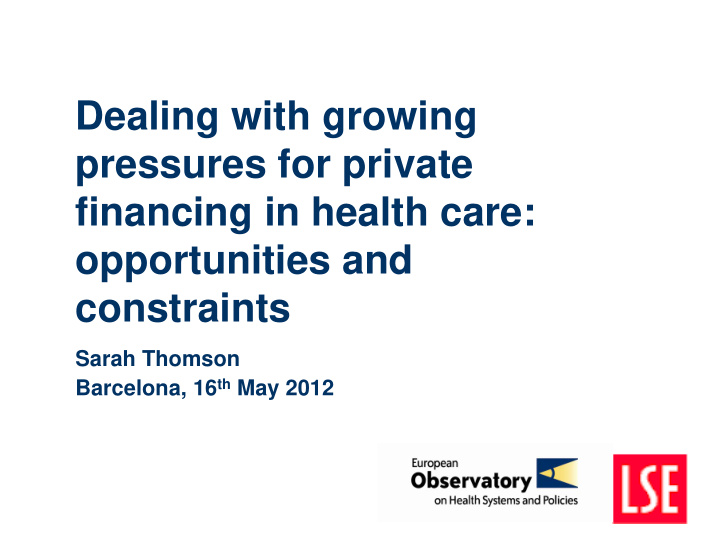



Dealing with growing pressures for private financing in health care: opportunities and constraints Sarah Thomson Barcelona, 16 th May 2012
Where do the pressures come from? � political preferences � potential winners � financial crisis
What are the opportunities? � An opportunity for clarity about policy goals, problems and tools � Do you know what you want, what the problems are and which tools will help you solve them?
Arguments for user charges � reduce excess demand caused by full insurance (moral hazard) � contain costs � direct people to more cost-effective use � raise revenue
User charges: a blunt tool with very limited selective effect Source: Siu et al (1986) New Engl J Med, RAND study 30 27 25 22 20 15 10 5 0 Appropriate admissions Inappropriate admissions % reduction in hospital admissions per 1000 person years among those who had to pay (compared to free care)
User charges do not seem to result in net savings Older people Poorer people % increase in incidence of 140 117 unwanted 120 97 outcomes 100 Source: Tamblyn et al (2001), JAMA 78 following 80 introduction of 60 prescription drug 43 40 charges (hospitalisation, 20 nursing home 0 admission, death) Unwanted Emergency outcomes* visits
Are user charges the right tool? � does it make economic sense to create financial barriers to care you want people to use? � would it be more effective to target supply? � requires careful policy design
Arguments for VHI � relieve pressure on public budgets � address gaps in coverage (population, services, costs)
What role for VHI? Market VHI role VHI covers Examples driver coverage groups excluded or Germany, Chile, substitutive breadth opting out NL pre-2006 coverage complementary Canada, NL, excluded services scope (services) Hungary coverage complementary statutory user Croatia, France, depth (user charges) charges Latvia, Slovenia consumer faster access & Ireland, Poland, supplementary satisfaction consumer choice UK Gaps in statutory coverage create space for VHI but are not sufficient for market development
Is VHI the right tool? � will VHI cover important gaps? � will those who need VHI have access to it? � can this be achieved without undermining value in public spending on health? � requires careful policy design, understanding of how VHI interacts with the health system, clarity about goals, regulatory capacity, oversight
Risks associated with VHI � VHI may exacerbate fiscal pressure � VHI may undermine value in public spending, especially if public resources subsidise private access � risk segmentation, tax relief, non-aligned incentives, distortion of public priorities: the larger the market, the larger the challenges � many of these risks could be avoided or mitigated by strong policy design
10 15 20 25 30 35 40 45 50 55 0 5 VHI does not do well in filling France Slovenia Germany VHI and OOP as % of total health spending, Ireland Cyprus gaps in coverage Netherlands VHI > 25% of private spending Spain Austria Belgium Portugal Luxembourg Malta Hungary Greece Finland Denmark UK Italy Latvia Lithuania Bulgaria Estonia EU (2009) Sweden Cz Republic Poland Romania Slovakia
Conclusions � user charges and VHI are not a panacea � not only are they not the answer to many common health policy problems – they may create new challenges � proceed with caution and clear principles
Recommend
More recommend